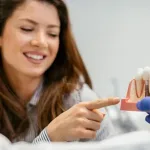The Reflexology Revolution: 4 Transformative Stages to Kickstart Your Best Year Yet

What’s reflexology, and how does it work?
Reflexology, a massage practice involving varied pressure on the feet, hands, and ears, has garnered popularity for its potential health benefits. Rooted in the belief that specific points on these body parts correspond to organs and systems, it aligns with traditional Chinese medicine’s concept of “qi,” vital energy flowing through the body. Stress or imbalance disrupts qi flow, potentially leading to illness, and reflexology seeks to restore balance. Reflexologists utilize detailed maps of pressure points, applying pressure to influence corresponding organs and systems.
From a Chinese medicine perspective, reflexology aims to maintain qi flow for overall well-being. British scientists found connections between skin and internal organs, suggesting reflexology’s gentle touch may calm the central nervous system, promoting relaxation and stress reduction. Additionally, reflexology might impact the brain’s perception of pain, providing relief from physical and emotional distress.
While scientific evidence is limited, potential benefits of reflexology include stress reduction, pain relief, mood enhancement, and overall well-being. It complements conventional medicine but is not a substitute. Those curious about its effects are encouraged to try a session with a skilled reflexologist.

People with foot fractures or unhealed wounds should avoid reflexology, as the therapy could exacerbate existing injuries. For those with osteoarthritis affecting the foot or ankle, consultation with a primary healthcare provider is recommended before starting reflexology. Additionally, individuals with vascular disease of the legs or feet should seek professional advice.
Reflexology may not be suitable for those with circulatory problems or a history of blood clots. It is crucial to discuss your medical history with your healthcare provider to ensure the treatment is safe for you.
If you have thyroid issues, athlete’s foot, or epilepsy, consulting with your healthcare provider is essential. They can provide guidance on any necessary modifications to prevent adverse effects.
It’s important to remember that reflexology complements conventional medicine but is not a substitute. Prioritizing your health and consulting with a professional if you have concerns is crucial. Always be mindful of your individual health circumstances and seek advice when needed.

Reflexology focuses on specific points on the feet, hands, or ears. Practitioners apply pressure to these reflex points using fingers, aiming to stimulate the body’s innate healing capabilities, restore balance, and address various ailments. Unlike massage, reflexology is not a full-body treatment and does not involve the manipulation of soft tissues or muscles. Its benefits include relaxation, stress reduction, and potential relief from issues like headaches, hormonal imbalances, and chronic pain.
On the other hand, massage has a broader scope, encompassing various techniques that manipulate the entire body’s soft tissues, muscles, and fascia. Massage therapists employ different strokes and pressure levels, customizing the treatment to individual needs. With diverse styles like Swedish, deep tissue, sports, and hot stone massage, the focus can be on muscle tension relief, pain alleviation, and overall relaxation.
In summary, reflexology targets specific reflex points, while massage works on the entire body or specific regions. Both approaches offer unique benefits and can complement each other for a holistic approach to well-being.
What body parts are used in reflexology?
In reflexology, specific body parts play a crucial role in the practice. Let’s explore which areas are commonly used:
- Feet:
- Main Focus: The feet are the primary area used in reflexology.
- Reflex Points: Practitioners apply pressure to specific points on the soles, tops, and sides of the feet.
- Correspondence: These points correspond to various organs, bones, and body systems throughout the entire body.
- Hands:
- Secondary Area: While the feet are most commonly used, reflexology can also involve the hands.
- Hand Reflex Points: Reflexologists apply pressure to specific points on the hands.
- Correspondence: These hand points correspond to different areas of the body, similar to the feet.
- Ears:
- Less Common: Reflexology occasionally includes the ears.
- Ear Reflex Points: Practitioners access points both inside the ear (as far as the finger can reach) and outside.
- Correspondence: These ear points also correspond to organs and systems throughout the body.
Remember that reflexology aims to promote relaxation, improve circulation, and maintain overall balance. While the exact mechanism of action isn’t fully understood, it’s a fascinating practice that continues to be explored!
How does reflexology work?
Reflexology is a fascinating practice that involves applying pressure to specific points on the feet, hands, and ears. Let’s explore how it works:
- Traditional Chinese Medicine Perspective:
- Reflexology rests on the ancient Chinese belief in “qi” (pronounced “chee”), which represents vital energy flowing through the body.
- According to this theory, stress or imbalance can block the flow of qi, leading to illness.
- Reflexology aims to keep qi flowing harmoniously, maintaining balance and preventing disease.
- Different body parts correspond to specific pressure points on the feet, hands, and ears.
- Reflexologists use maps of these points to determine where to apply pressure, believing that their touch sends healing energy throughout the body.
- Nervous System and Calming Touch:
- British scientists in the 1890s discovered that nerves connect the skin to internal organs.
- Reflexologists’ gentle touch may calm the central nervous system, promoting relaxation similar to any form of massage.
- By stimulating nerves, reflexology may ease stress and enhance overall well-being.
- Brain’s Role in Pain Perception:
- Sometimes, the brain creates pain as a subjective experience.
- Reflexology may reduce pain by affecting the brain’s perception.
- It can alleviate physical pain and even address emotional or mental distress.
- Zone Theory:
- Another belief is the zone theory, which divides the body into 10 vertical zones.
- Each zone corresponds to specific fingers and toes.
- Practitioners believe that touching these points allows access to every body part within a particular zone.
Potential Benefits:
- Reflexology is linked to several potential benefits, including:
- Stress Reduction
- Pain Relief
- Mood Enhancement
- General Well-Being
Remember, reflexology complements conventional medicine but isn’t a substitute. If you’re curious, consider trying a session with a skilled reflexologist to experience its effects firsthand!
What are the key points targeted in the discussed practices for well-being?
The practices focus on specific areas of the feet, hands, or ears, aiming to stimulate reflex points associated with various bodily systems. These targeted points play a role in stress reduction, mood enhancement, improved circulation, and potential symptom relief.
How often should these techniques be incorporated into a routine for optimal benefits?
The frequency of incorporating these techniques can vary based on individual preferences and needs. However, dedicating regular sessions, whether daily or as needed, may contribute to sustained well-being. Spending at least 10-15 minutes on each foot during a session is a common guideline.
Are these practices intended to replace conventional medical treatments?
No, these practices are not substitutes for conventional medical treatments. They are meant to complement existing healthcare approaches. It’s crucial to consult with healthcare professionals for personalized advice, especially if individuals have specific health concerns or conditions.
Can anyone practice these techniques, or are there contraindications to consider?
While these practices are generally considered safe, individuals with existing foot fractures, unhealed wounds, or certain medical conditions should exercise caution or consult healthcare providers before attempting them. Adapting the pressure based on personal comfort is recommended.
What visualizations or intentions are suggested during these well-being practices?
As individuals work on reflex points, visualizing relaxation and healing is encouraged. Setting positive intentions for overall well-being can enhance the holistic benefits of these practices. The focus is on creating a mindful and intentional connection between the physical and mental aspects of well-being.













